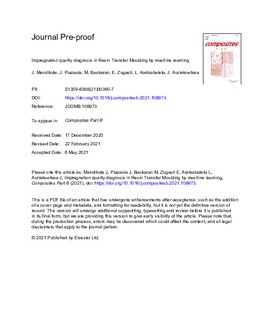| dc.contributor.author | Mendikute, Julen | |
| dc.contributor.author | Plazaola Madinabeitia, Joanes | |
| dc.contributor.author | Baskaran, Maider | |
| dc.contributor.author | Zugasti, Ekhi | |
| dc.contributor.author | Aretxabaleta, Laurentzi | |
| dc.contributor.author | Aurrekoetxea, Jon | |
| dc.date.accessioned | 2021-06-03T14:43:53Z | |
| dc.date.available | 2021-06-03T14:43:53Z | |
| dc.date.issued | 2021 | |
| dc.identifier.issn | 1359-8368 | en |
| dc.identifier.other | https://katalogoa.mondragon.edu/janium-bin/janium_login_opac.pl?find&ficha_no=163724 | en |
| dc.identifier.uri | https://hdl.handle.net/20.500.11984/5309 | |
| dc.description.abstract | In recent years, several optimization strategies have been developed which reduce the overall defectiveness of the RTM manufactured part. RTM filling simulations showed that, even using optimized injection strategies, local variations in permeability could still generate local defects in the part. Such defects must be identified quickly and accurately right after the injection phase in order to repair or scrap the part. The present paper analyses the feasibility of diagnosing the quality after the injection stage of RTM parts by Machine Learning. The diagnosis was performed using a Supervised Learning binary classification model trained with synthetic data set. Among the different predictive models studied, Extreme Gradient Boosting and Light Gradient Boosting Machine were the most accurate models for predicting the filling quality of RTM, with an accuracy of 84.9% and 83.35%, respectively. In addition, a scaling of the ML model allowed not only to predict the quality of the part but also to locate the areas where the defect was generated. The computation time of the trained ML model versus the FEM model, both computed with a workstation (CPU Intel Xeon Processor E5.2690 with 2.9 GHz–8 core), were compared. In the specific case studied, a reduction from 360 s to 1 s was observed in the computation time utilizing the trained ML model. Thus, Supervised Learning predictive models can be used for diagnosing the composite quality. They are fast enough to be integrated in real processes and could be helpful for designing the monitoring system. | en |
| dc.description.sponsorship | Gobierno Vasco | es |
| dc.language.iso | eng | en |
| dc.publisher | Elsevier Ltd. | en |
| dc.rights | © 2021 Elsevier Ltd. | en |
| dc.subject | Supervised learning | en |
| dc.subject | Quality diagnosis | en |
| dc.subject | Composites manufacturing | en |
| dc.subject | Resin transfer moulding | en |
| dc.title | Impregnation quality diagnosis in Resin Transfer Moulding by machine learning | en |
| dc.type | http://purl.org/coar/resource_type/c_6501 | |
| dcterms.accessRights | http://purl.org/coar/access_right/c_f1cf | en |
| dcterms.source | Composites Part B: Engineering | en |
| local.contributor.group | Tecnología de plásticos y compuestos | es |
| local.contributor.group | Análisis de datos y ciberseguridad | es |
| local.description.peerreviewed | true | en |
| local.identifier.doi | https://doi.org/10.1016/j.compositesb.2021.108973 | en |
| local.relation.projectID | GV/Programa predoctoral de formación del personal investigador no doctor 2018-2019/PRE_2018_1_0338/CAPV// | en |
| local.relation.projectID | GV/Elkartek 2017/KK-2017-00062/CAPV/Composites para automoción fabricados mediante RTM adaptada a filosofía Industry 4.0/RTM4.0 | en |
| local.relation.projectID | GV/Ikertalde Convocatoria 2016-2021/IT883-16/CAPV/Tecnología de Plásticos y Composites/ | en |
| local.embargo.enddate | 2023-09-30 | |
| local.source.details | Vol. 221. N. artículo 108973, 2021 | en |
| oaire.format.mimetype | application/pdf | |
| oaire.file | $DSPACE\assetstore | |
| oaire.resourceType | http://purl.org/coar/resource_type/c_6501 | en |
| oaire.version | http://purl.org/coar/version/c_71e4c1898caa6e32 | en |







